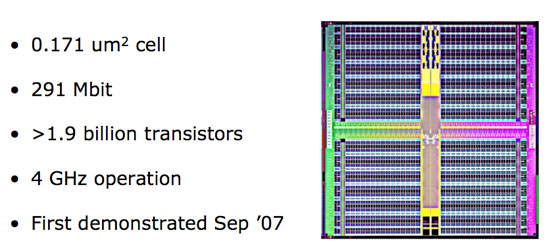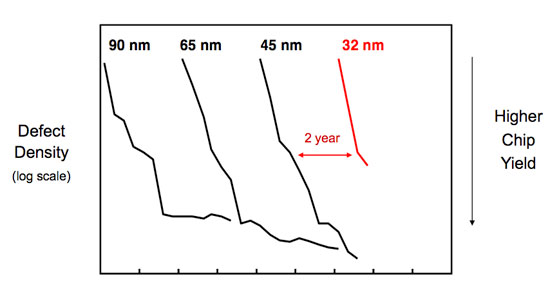Intel's 32nm Update: The Follow-on to Core i7 and More
by Anand Lal Shimpi on February 11, 2009 12:00 AM EST- Posted in
- CPUs
Fat Pockets, Dense Cache, Bad Pun
Whenever Intel introduces a new manufacturing process the first thing we see it used on is a big chip of cache. The good ol’ SRAM test vehicle is a great way to iron out early bugs in the manufacturing process and at the end of 2007 Intel demonstrated its first 32nm SRAM test chip.

Intel's 32nm SRAM test vehicle
The 291Mbit chip was made up of over 1.9 billion transistors, switching at 4GHz, using Intel’s 32nm process. The important number to look at is the cell size, which is the physical area a single bit of cache will occupy. At 45nm that cell size was 0.346 um^2 (for desktop processors, Atom uses a slightly larger cell), compared to 0.370 um^2 for AMD’s 45nm SRAM cell size. At 32nm you can cut the area nearly in half down to 0.171 um^2 for a 6T SRAM cell. This means that in the same die area Intel can fit twice the cache, or the same amount of cache in half the area. Given that Core i7 is a fairly large chip at 263 mm^2 I’d expect Intel to take the die size savings and run with them. Perhaps with a modest increase to L3 cache size.

A big reason we’re even getting this disclosure today is because of how healthy the 32nm process is. Below we have a graph of defect density (number of defects in silicon per area) vs time; manufacturing can’t start until you’re at the lowest part of that graph - the tail that starts to flatten out:

Intel’s 45nm process ramped and matured very well as you can see from the chart. The 45nm process reached lower defect densities than both 65nm and 90nm and did it faster than either process. Intel’s 32nm process is on track to outperform even that.
Two Different 32nm Processes?
With Intel now getting into the SoC business (System on a Chip), each process node will now have two derivatives - one for CPUs and one for SoCs. This started at 45nm with process P1266.8, used for Intel’s consumer electronics and Moorestown CPUs and will continue at 32nm with the P1269 process.

There are two major differences between the CPU and SoC versions of a given manufacturing process. One, the SoC version will be optimized for low leakage while the CPU version will be optimized for high drive current. Remember that graph comparing leakage vs. drive current of 45nm vs. 32nm? The P1268 process will exploit the arrows to the right, while P1269 will attempt to push leakage current down.
The second difference is that certain SoC circuits require higher than normal voltages and thus you need a process that can tolerate those voltages. Remember that with a SoC it’s not always just Intel IP being used, there are many third parties that will contribute to the chips that eventually make their way into smartphones and other ultra portable devices.
The buck doesn’t stop here, in two more years we’ll see the introduction of P1270, Intel’s 22nm process. But before we get there, there’s a little stop called Sandy Bridge. Let’s talk about microprocessors for a bit now shall we?










64 Comments
View All Comments
Calin - Wednesday, February 11, 2009 - link
[quote]but at 45nm Intel’s switched from a SiO2 gate dielectric to a high-k one using Halfnium[/quote]It's Hafnium (even if halfnium sounds better)
aapocketz - Wednesday, February 11, 2009 - link
hafnium is great for dielectrics. I hope their yields are good since its very expensive. Most CVD processes are only efficient in the single digit %.MrPoletski - Wednesday, February 11, 2009 - link
doesn't sound as good as unobtanium.melgross - Wednesday, February 11, 2009 - link
I just don't see how AMD competes, long term. With Intel moving to 32nm faster than expected, and with mainstream parts, that would put them 18 months ahead of AMD, unless somehow, they manage to pull off a similar coup. But it doesn't look as though they will be able to.We might remember that a bit over a year ago, AMD stated quite boldly, that they would move to within 6 months of Intel's process changes, but they are still a year behind. No progress there. Unless they can manage to switch around their roadmap the way Intel seems to be able to do, they will fall further behind.
LordanSS - Wednesday, February 11, 2009 - link
I think we should wait and see how things will turn out. Now that AMD has spun off their fabs to a separate company, it's no longer their (AMD) job to invest on new manufacturing processes.Hopefully, now that the Foundry company has more "freedom", and injection of capital from sources outside of AMD, it'll be able to increase the pace of the shrinking processes.
Besides all that, doesn't AMD graphics division make use of TSMC's fabs to make their chips?
PrinceGaz - Wednesday, February 11, 2009 - link
TSMC's fabs will always be a generation or so behind the like of Intel's own, just as AMD (with IBM's assistance) were ahead of them in the past.I can't see AMDs fab company getting much outside investment in the current economic climate -- new state-of-the-art fab facilities are too expensive and there is no guarantee of profitable contracts to keep them busy. The Foundry Company is never going to catch up with Intel unless a miracle happens, and TSMC etc will likely be direct competitors.
Intel are speeding up their fab and process development because they have money in the bank and continued profits to fuel it. AMD are in dire-straits financially and making a loss. Even with the risks hedge-fund managers take, they'd be mad to put money into AMD just now.
Triple Omega - Sunday, February 15, 2009 - link
I wouldn't count AMD out just yet if I were you. One false move from Intel and an unexpected innovation from AMD and they're back on their feet. If in Q4 2007 you said Ati would level the playing field with Nvidia the following year most would call you crazy, yet it still happened. So I still have hopes for AMD.ucsdmike - Wednesday, February 11, 2009 - link
AMD's staff will be hitting the bar tomorrow.This is amazing news from Intel. It is an exciting move.
Looking forward to cooler and longer running laptops in the near future.
icecold101 - Monday, August 24, 2009 - link
AMD still has one thing that intel dosent have... low prices. these new cores will cost more than $1000! In the slumping economy it isn't the best time to ask for top dollar.Ryun - Thursday, February 12, 2009 - link
More reason to work extra hard maybe?In all seriousness, I have a feeling AMD might pull a rabbit out of it's hat like ATi did with the 4 series with their new architecture. Actually, technically they did with Phenom II but really it was just too late in the game to make the significant dent that ATi's 4 series did (though I'd say the triple cores this round are a big win).
At any rate, 2011 (Bulldozer, or whatever they're calling it now) better be huge. The 65nm X2s were somewhat competitive with Conroe, but after that it just started going downhill. If Bulldozer doesn't do it I don't think AMD is going to be able to get back up. =(